NVIDIA's GeForce GT 430: The Next HTPC King?
by Ryan Smith & Ganesh T S on October 11, 2010 9:00 AM ESTPower, Temperature, & Noise
We only have 1 GT 430 card on hand, so unlike past articles we cannot compile any data on the load voltages of this line of cards. Our lone Asus card has a load voltage of 1.08v, and an idle voltage of 0.88v. Idle clocks are 50.6MHz for the core, and 270MHz effective for the memory.
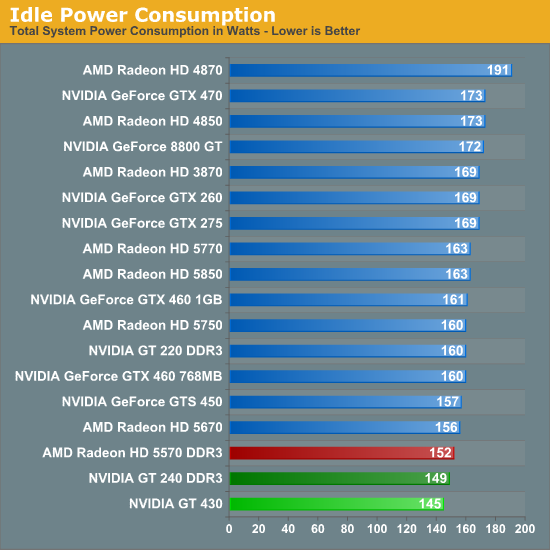
While GT 430 may not be competitive on a performance-per-dollar basis, it’s hard to argue with these power results. Even at these low wattages where our 1200W power supply isn’t very efficient, the GT 430 still delivers an idle power consumption level 7W under the Radeon 5570, and an even larger 11W advantage over the otherwise performance-superior Radeon 5670. We can’t measure the card’s actual power consumption and NVIDIA does not provide a reference level, but the GT 430 can’t be drawing more than a couple of watts here.
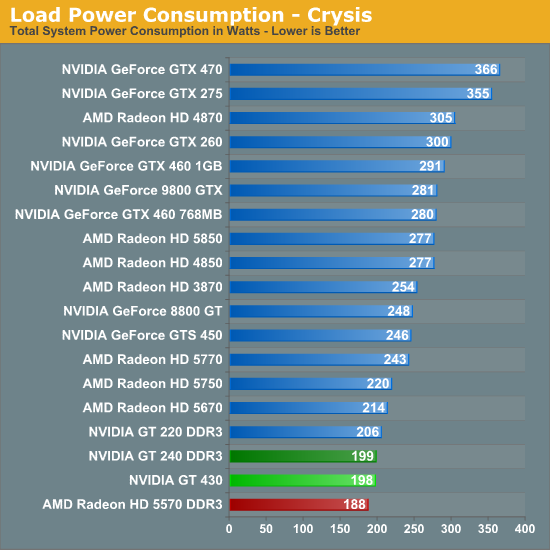
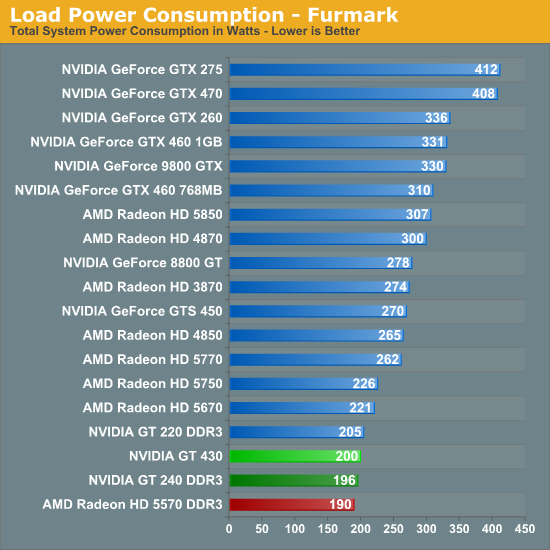
Under load things are less rosy for the GT 430. Under Crysis it ends up drawing 10W over the 5570, which serves as yet another testament to the amazing level of performance-per-watt that AMD has been able to attain; remember that the 5570 had better performance at the same time. Under Furmark the situation is just as bad, but at this point we’re looking at a more pathological case. Overall 10W isn’t going to break the bank in an HTPC (especially since these cards would rarely get up to full clocks in the first place) but it’s something to consider if every watt is going to count.
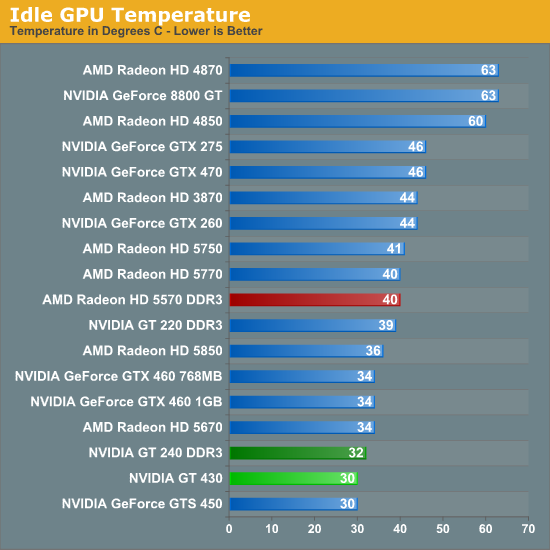
When it comes to idle temperatures, the GT 430 is second to none. With the card only consuming a couple of watts at idle in the first place, its idle temperatures are barely above room temperature (and even closer to ambient case temperatures). It’s tied with the GTS 450, which impressed us last month with its highly capable cooler. Meanwhile our 5570, which is a low-profile card just like the GT 430, ends up being a good 10C higher. AMD’s higher idle power consumption directly translates to a higher idle temperature.
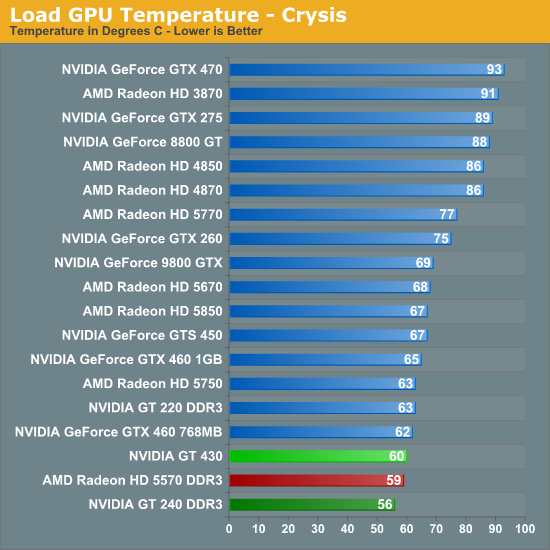
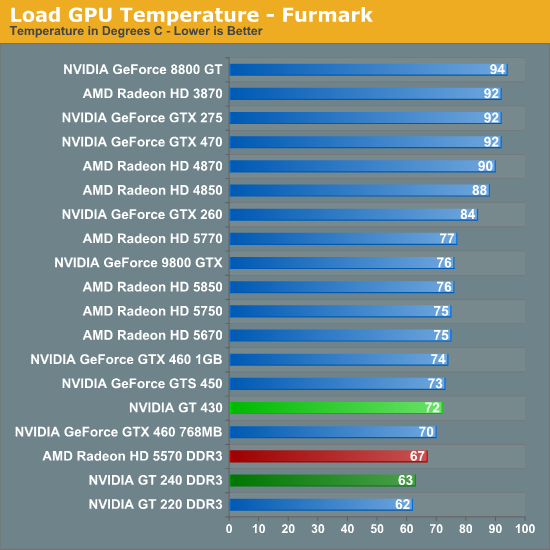
Looking at load temperatures, these results aren’t all that surprising given the cooler in use. The Asus cooler is practically a passive cooler, as the small fan is not capable of moving much air (though it is unusual to not see Asus aggressive on cooling). As a result it manages to reach higher temperatures, but we’re still only talking about 60C under Crysis and 72C under Furmark. This is worse than the 5570 and its larger fan by a bit, but not significantly so.
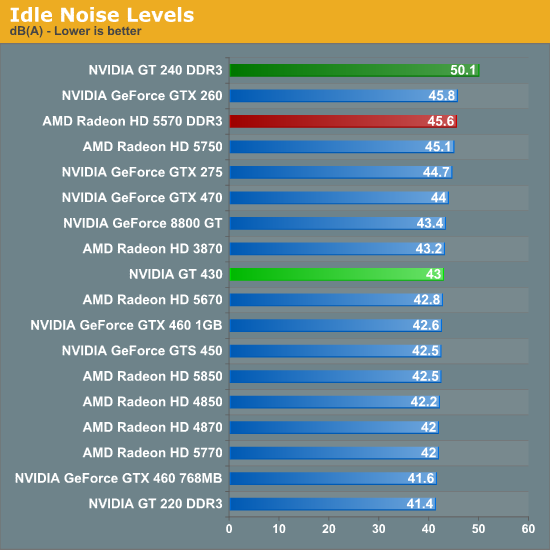
At idle the GT 430 is consistent with our other cards. With the exception of a couple ridiculous cards like our GT 240 and in this case the 5570, everything is at roughly 42-44dB(A). The 5570 is more fan than heatsink, which is likely why it has such a poor showing here compared to the GT 430.
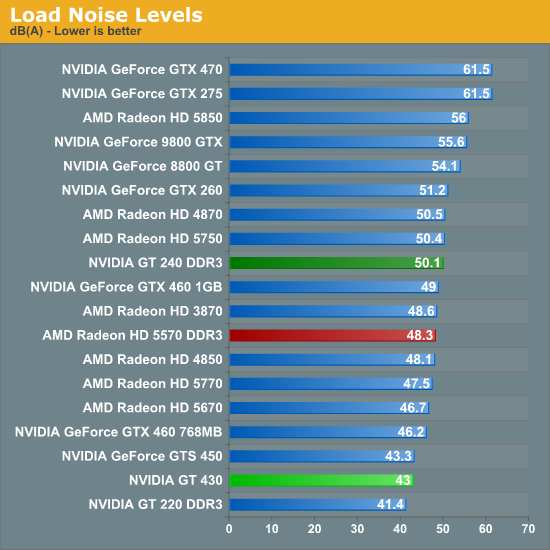
The payoff of accepting higher temperatures is less noise to contend with. The GT 430 never needs to ramp up its fan in our tests, delivering a load noise level even lower than the GTS 450, and only worse than a GT 220 that runs up against ambient noise levels. If you want to make a good HTPC card then it needs to be silent, and Asus/NVIDIA have delivered on that here. It’s not quite silent since it’s not passive, but it’s about as close as one can reasonably achieve. It’s also noticeably better than the 5570, a card which is by no means noisy. If noise is a primary concern then the GT 430 is a very good candidate for a HTPC.










120 Comments
View All Comments
dnd728 - Tuesday, October 12, 2010 - link
That was word for word per ATI's instructions, if I wasn't clear enough.If I hadn't followed their instructions, then it would all have been my fault, right?
mr_datawolf - Tuesday, October 12, 2010 - link
You were on an ALL In WONDER! What did you expect? Talk about niche!Look, I totally agree ATI has done many horrible things with their drivers in the past. But for most of the AIW's life it was the only real tv card out there, in the consumer market. The feature set was WAY beyond everyone else anywhere near that price point.
Also I used an NVIDIA card that competed with the AIW and it was just as annoying in driver.
dnd728 - Tuesday, October 12, 2010 - link
Among others.I don't agree it's such a niche product, they've sold quite a few – it's not like a combination of hardware.
I agree that they had the best feature set, they just kept crashing my systems.
I can't recall a single time that I left it to record a show unattended and it actually did.
dnd728 - Tuesday, October 12, 2010 - link
And btw, I did also try driver sweeper with no luck.heflys - Tuesday, October 12, 2010 - link
Good question. I find it odd how all the ATI cards somehow failed every time, yet the Nvidia cards worked flawlessly. Yet, for my first ATI purchase in 8-9 years, the card works flawlessly. No driver issues what-so-ever. Lets say that I'm a little bit skeptical.SilthDraeth - Tuesday, October 12, 2010 - link
I would say that one reason would be you.I have used AMD cards exclusively for the last 10 years, and never had a single issue. I have also worked on peoples computers with NVIDIA and never had a single issue.
I am not sure what you were doing, and it very well could have been a driver issue, or bad part, but being that most computer issues are user error, that is where I am going to place my money.
dnd728 - Tuesday, October 12, 2010 - link
Then you'll loose your money. I'm in no way novice and installed tons of hardware with no issues. There's really no place for me to go wrong installing a graphics card in a brand new install of windows.Again, I call ATI to investigate. Be my guest.
heflys - Tuesday, October 12, 2010 - link
Can you elaborate on the errors that you encountered, which cards (exact model if possible) you owned; the manufacture of said card and your system specs? Thanks.I must say though, I'm not sure why you kept buying ATI if each one failed in some manner.
dnd728 - Tuesday, October 12, 2010 - link
That would be a lot to recall, search for old gear and receipts and detail just to look more reliable here. AMD also seem to have deleted my old ATI service account with nearly all correspondences. I will do it if I know it goes someplace useful.The errors varied with card, driver version, MMC version and windows version. Each card came with its own full long story. There's just too much to list from probably over a decade.
PCs, Windows, cards were from all of that time range and from different manufacturers (except windows...). Cards by ATI, sapphire, hercules? oem by mic? (that's what the sticker here says) I was mostly bugged by bsods and other forms of crashes and freezes with all cards. One ended up dying, another deteriorated rapidly and if installed would probably die soon too. But there are many lesser bugs too. Change driver/Windows/MMC version and you get more/less crashes and some strange new bugs.
I didn't buy them all one after the other. Time passed and I was thinking - it's working for other people, got nice reviews, it's a different card than what I previously had, a different card maker, a different PC, different Windows version, so why shouldn't it work? A couple I got preinstalled, without much choice. And with the first ATI card or two ...well I wasn't aware yet.
Now I'm accused of giving them too much credit.
heflys - Tuesday, October 12, 2010 - link
Interesting......Seems you just have bad luck with ATI for some reason. I'd chalk it up to crappy side manufacturers. I think it's telling when companies like "Hercules GPU' " are no longer around. Also, at the time, ATI and 3dfx (now owned by Nvidia) were lending out their tech to every fool with the potential to manufacture cards. There were a number of crap products during those times, I wouldn't be surprised if you experienced some issues. What was your problem with the 5xxx series though?